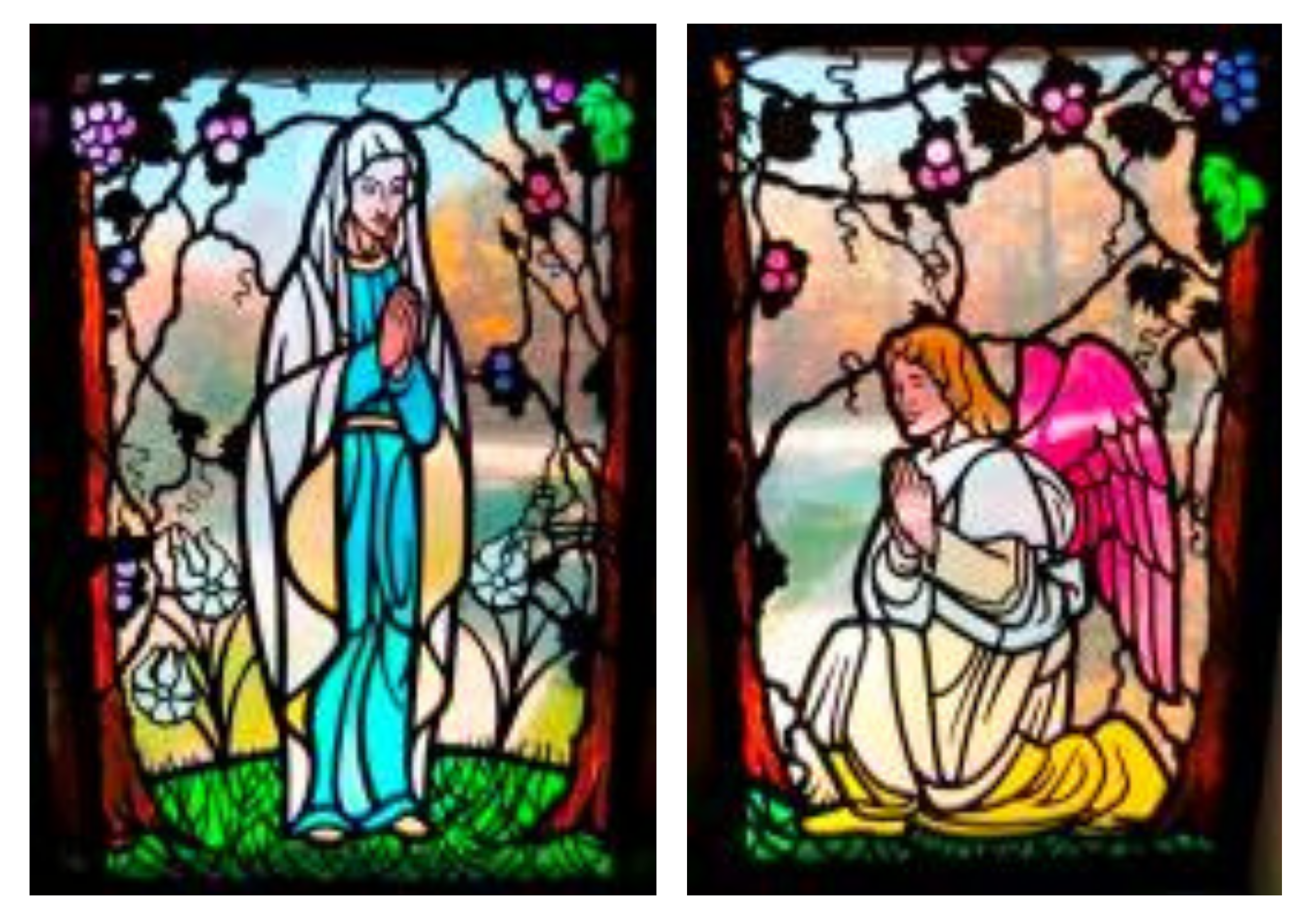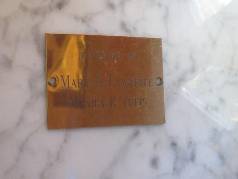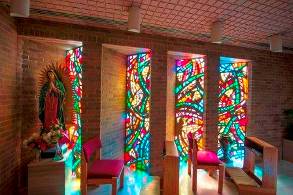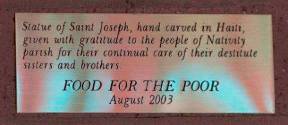Text by Bob Clark
Photographs by Fritz Ernst
The Church Entrance
The open door symbolizes the parish’s welcome to everyone to enter.
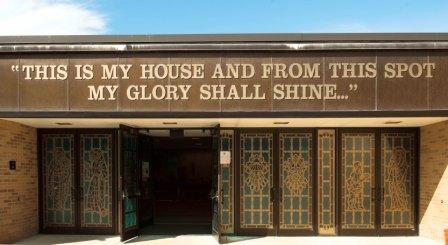
The Sanctuary
As we view the front wall of the church, including the Sanctuary, we see the following (from left to right): the seven stained glass wall panels, the statue of the Virgin Mary, the altar, the statue of the Risen Christ, the tabernacle, the statue of Saint Joseph, and the Greek cross, backed by a wall hanging in a color appropriate to the liturgical season. The second photo shows the Sanctuary as it appeared during the Christmas season.
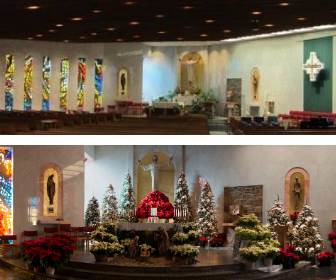
Here are some details of the Sanctuary: first, the Nativity scene (crèche), and below that the statues of the Virgin Mary and Saint Joseph.
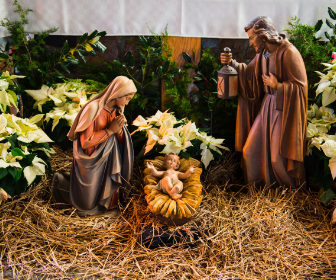

To the right of the Sanctuary a large Greek cross hangs framed against a background cloth that is changed to reflect the color of the liturgical season. Behind the cloth is a mosaic depicting the Nativity of the Lord. Following are photos of the cross, the mosaic and two small plaques on the wall nearby.
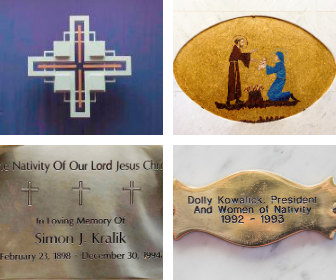
The church has two statues of Christ, one crucified and the other resurrected. For most of the year, the risen Christ hangs at the front of the church on the wall behind the Sanctuary and the crucified Christ is on the rear wall where parishioners see it as they leave the church. During Lent, the crucified Christ is brought to the front and replaces the risen Christ until Easter Sunday.
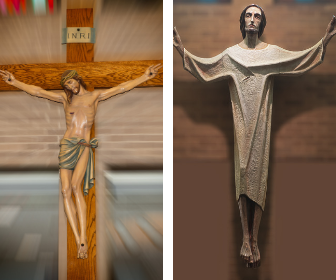
The Stained Glass Panels
Many worshipers and visitors to the church are struck by the seven stained glass panels along the left wall (as we face the altar). Like the Stations of the Cross, these panels were installed in 1979 during the final stages of the church’s construction. The artisans were from the Carl Moser Studios of Dobbs Ferry, New York.
The ambiguity of this art was intentional. Father Ready believed that art should not be easily grasped or understood at first glance: “If you solve it instantly,” he wrote, “you will see it frequently, but you will look at it only once. If you work to solve, then new insights will come each and every time that you truly look at it.” So he gave these instructions to the artist who designed the panels, and the artisan who rendered them in glass and stone.

Father Ready’s drawing of the stained glass panels.
“The window should express the presence of God throughout creation from the beginning in the Old Testament to the last book in the New Testament which has its mystical future. Christ and the Cross is the overpowering theme, best expressed in the light of the resurrection … for we are an Easter people! We are called to follow the Risen Christ. The blue of purification is applicable throughout the entire span of time with Christ as its source of forgiveness. The circular motion of color reveals Christ’s influence from the beginning to the end of time. The brightness of the Christ symbol … the cross, given light both before and after. Hope is endless.
- Basically the Trinity – Presence of God
- Christ (Cross) ever present
- God the Father (rainbow Signifying Union) – God’s Pardon & Forgiveness of Man for his sins (past)
- Holy Spirit – Peace – we feel comfortable here
- Butterfly – Resurrection (future)
- Tree of Jesse (Genealogy of Christ) – Also Tree of Life
- Water – Purification”

On the interior wall of the panel to the far left there is a small dedication plaque that reads: “In Memory of /Mary A. Lawrence/Monica A. Tufts”.
The small chapel adjacent to the church also has stained glass panels similar to those in the larger church, as can be seen in these two photos.
Nearly all of the statuary and stained-glass art were installed during the pastoral tenure of Father Sal. The only statue that Father Martin has installed is that of Saint Joseph that stands in the Church vestibule. It was carved out of mahogany by a family in Haiti and given as a gift to Nativity in appreciation of what the parish has done in Haiti through Operation Starfish.
Stained Glass Windows and Doors
In 1989-1990, the church’s original doors and large windows were replaced by a set of stained glass doors and windows. The work was performed by The Baut Studios of Swoyersville, Pennsylvania, a fourth-generation family-owned studio specializing in ecclesiastical art and stained glass since 1926. Some twenty craftsmen, including six artists, were employed in the manufacture of these doors and windows. The doors alone cost $27,500.00. The windows and doors were dedicated on May 20, 1990. The following text in italics is drawn from the booklet produced to commemorate that event.
Four central themes are represented in the stained-glass windows and doors in Nativity …: that of the Nativity itself; the seven Sacraments which are the lifeblood of the Church; the three theological virtues which help to direct our relationship with the Lord; and the most visible and precious treasure of our parish, our children.
The Front Doors
The two end doors … picture two figures central to the Nativity: The Madonna and Child. The wording between the first and second set of doors is a prayer invoking Mary as the “Mother of All Seasons” reminding us of her continual presence and our continual need of her. In the first door on the left, there is portrayed the scene of La Madonna della Strada (or Our Lady of the Street). Embracing the Child Jesus, she is shown offering her assistance to the poorest of the poor, the children of the street. … The first door on the right combines the image of Our Lady with one of the important persons of the Nativity, St. Francis of Assisi. It depicts the Blessed Mother presenting the Christ Child to St. Francis. …The central doors portray the symbols of the three sacraments of initiation and union, Baptism, Confirmation and the Holy Communion. It is through these sacraments that one becomes a member of the Church and is confirmed and nourished in his faith. … Between the second and third set of doors is written “Come O Holy Spirit Upon Us,” reminding us of the graces of the Holy Spirit that come to us in Baptism and Confirmation. Between the third and fourth set of doors is written “I am the bread of life,” the stubborn reminder from John 6:35 that when, at the Last Supper, Our Lord said, “This is my body,” He meant what He said. … The door to the All-Purpose Room shows an image of our Blessed Lord with the little children. As He urged His apostles to “suffer the little children to come unto Me,” He invites all children to come to Him. It was appropriate to use this scene for this door since … this room … is used for so many of the activities in our parish for children …

The Large Windows
The four large windows in the Church and in the All-Purpose Room [Note: This is now the gift shop.] portray the central characters of the Nativity: The Holy Family, the Angels, the Shepherds, and the Wise Men. … The most important of the four groups is, of course, the Holy Family. For this reason, it is located in the place of prominence in the Church, the sanctuary. … Quite fittingly, the angels are shown [in the window] over the choir. As they sing the Lord’s praises and announce to all the birth of the newborn King, they remind us as well of the importance of this great event. … The [third] window shows [the shepherds] looking upward to the heavens as they hear the message of the angels and directs our attention to the source of that message, God himself. … [The fourth] window shows the three wise men who came from far off to see the newborn King. … [T]hey signify that Christ is not just for the Jews, but for all men.
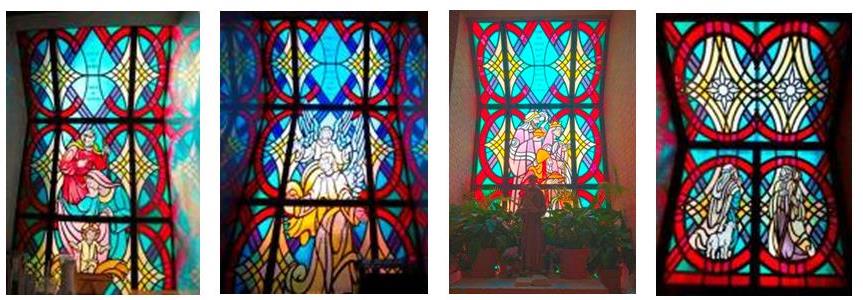
In front of the third window, of the shepherds, there now stand the altar and statue of Saint Anthony, details of which are seen below. The small plaque at the base of the statue reads: “In Loving Memory/Of/Lillian and Howard Webb Edgar”. The fourth window, of the wise men, is located at the rear of the gift shop.

The Smaller Windows
Across the back of the church are seven smaller windows alternating between the remaining four sacraments [Penance, Anointing of the Sick, Holy Orders, and Matrimony] and the three theological virtues [Faith, Hope, and Charity]. Each of the two sets has a central theme. In the windows symbolizing the four sacraments there is a hand coming from above. … In the three windows depicting the three theological virtues, there is the central image of the cross.
The Chapel Door
At the entrance to the Chapel of the Blessed Sacrament is a life-size image of St. John Neumann giving a blessing with a monstrance. …
The Star of Bethlehem
As one enters the church the eyes are directed to the four-pointed Star of Bethlehem in the center of the floor of the vestibule. This star is carried throughout the church as a predominant theme in the windows and doors.
Finally, while still in the church we see on the left wall (as we look at the altar) a statue of Saint Jude, accompanied by a small plaque that reads: “The Letter to St. Jude, Verse 25/To the only God our Savior/Through Jesus Christ our Lord be/glory, majesty, dominion and authority/before all time and now and forever./Amen/Our love and prayers to Nativity Church/Cesar and Rhina Ugaz Family/10-25-92”.

School Statuary
The passageway between the church and the school building was originally intended to be an atrium. The left photo shows it as it was originally, with potted plants. Today, however, the wall serves to display art work, photos, and other decorative and significant wall hangings, as shown in the two right photos.
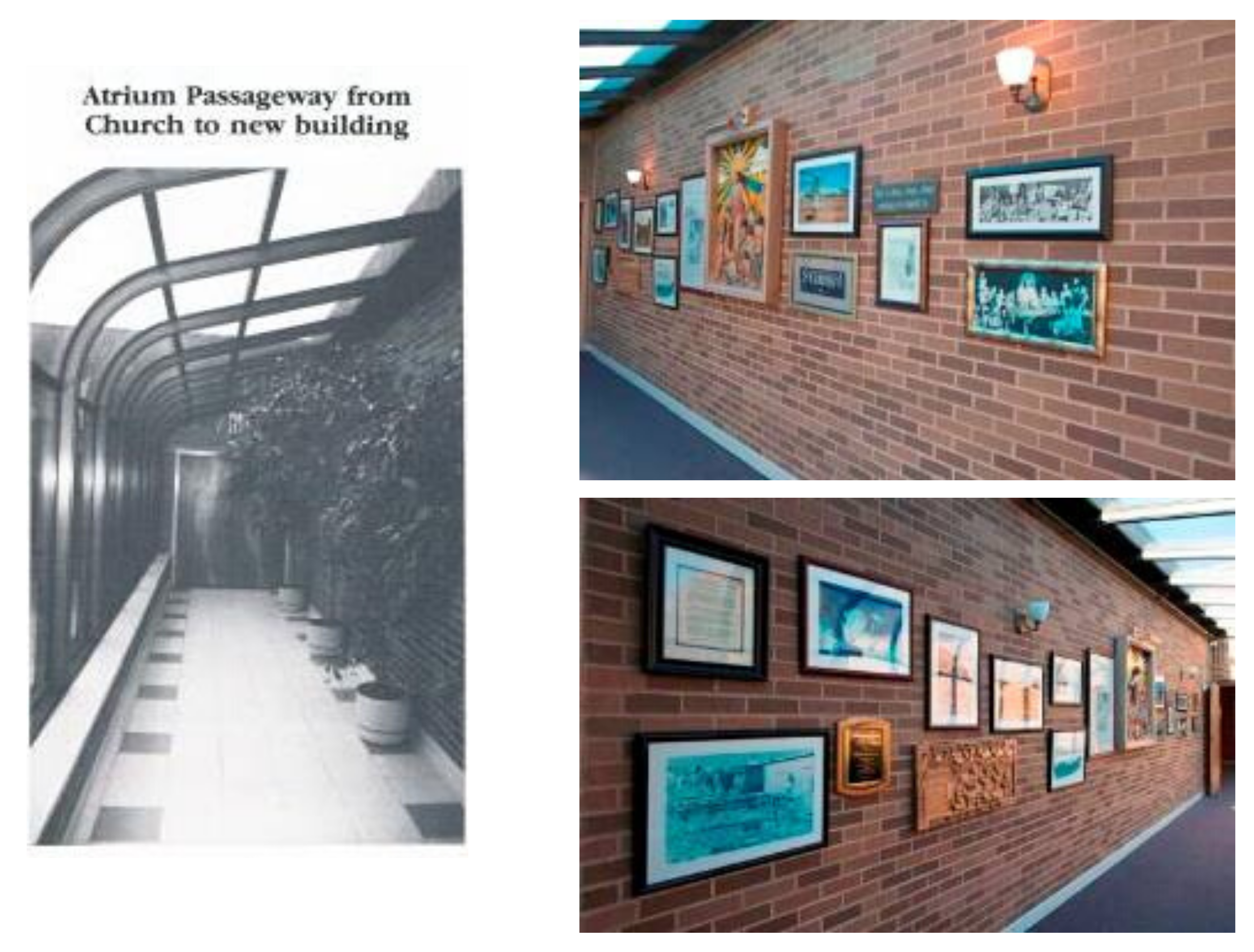
At the entrance of the school stands a statue of the Virgin Mary holding the Infant Jesus. The base was originally intended to contain a fountain but is now filled with stones and potted plants.
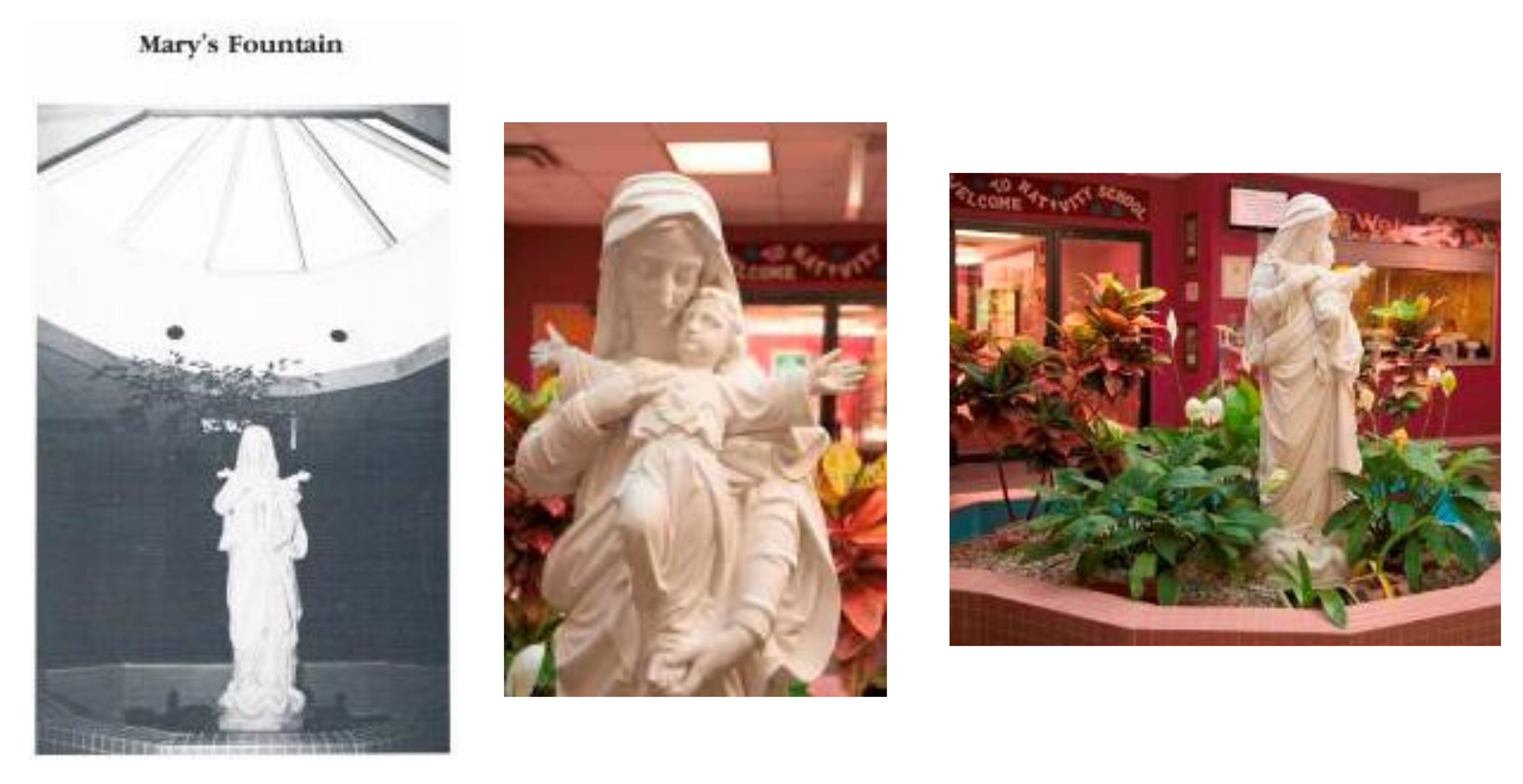
In a windowed alcove inside the school, near the school chapel, there is a statue of Saint Francis. This statue is usually surrounded by potted plants.
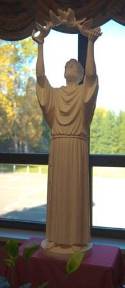
In the school chapel itself there are some interesting stained glass windows as well, including the Virgin Mary and an angel in prayer.
